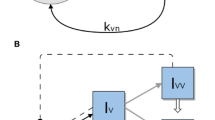Abstract
Population dynamics of two-host species under direct transmission of an infectious disease or a pathogen is studied based on the Holt–Pickering mathematical model, which accounts for the influence of the pathogen on the population of the two-host species. Through rigorous analysis and a numerical scheme of study, circumstances are specified under which the shared pathogen leads to the coexistence of the two-host species in either a persistent or periodic form. This study shows the importance of intrinsic growth rates or the differences between birth rates and death rates of the two host susceptibles in controlling these circumstances. It is also demonstrated that the periodicity may arise when the positive intrinsic growth rates are very small, but the periodicity is very weak which may not be observed in an empirical investigation.
Similar content being viewed by others
References
Anderson R.M. and May R.M. (1979). Population biology of infectious deseases: Part I. Nature 280: 361–367
Anderson R.M. and May R.M. (1981). The population dynamics of mioparasites and their invertebrate hosts. Phil. Trans. R. Soc. Lond. B. Biol. Sci. 291: 451–524
Begon M. and Bowers R.G. (1992). Dease and community structure: the importance of host self-regulation in a host-pathogen model. Am. Nat. 139: 1131–1150
Briggs C.J., Hails R.S., Barlow N.D. and Godfray H.C.J. (1995). The dynamics of insect–pathegon interactions. In: Grenfell, B.T. and Dobson, A.P. (eds) Ecology of Infectious Desease in Natural Populations, pp 295–326. Cambridge University Press, Cambridge
Burden R.L. and Faires J.D. (1988). Numerical Analysis. PWS-KENT, Boston
Cantrell R.S., Cosner C. and Fagan W.F. (2001). Brucellosis, botflies, and brainworms: the impact of edge habitats on pathogen transmission and species extinction. J. Math. Biol. 42: 95–119
Edelstein-Keshet L. (1988). Mathematical Models in Biology. McGraw-Hill, New York
Elton C.S. (1927). Animal Ecology. Sidgwick and Jackson, London
Gantmacher F.R. (1960). The Theory of Matrices, vol. II. Chelsea Publishing, New York
Greenman J.V. and Hudson P.J. (1997). Infected coexistence instability with and without density-dependent regulation. J. Theor. Biol. 185: 345–356
Holt R.D. (1977). Predation, apparent competition and the structure of prey communities. Theor. Popul. Biol. 12: 197–229
Holt R.D. (1984). Spatial heterogeneity, indirect interactions and the coexistence of prey species. Am. Nat. 124: 337–406
Holt R.D. (1993). Apparent competition and enemy-free space in insect host-parasitoid communities. Am. Nat. 142: 623–645
Holt R.D. and Pickering J. (1985). Infectious desease and species coeixstence: a model in Lotka–Volterra form. Am. Nat. 126: 196–211
Jansen V.A.A. and Sigmund K. (1998). Shaken not stirred: on permanence in ecological communities. Theor. Popul. Biol. 54: 195–201
Liu W.M. (1994). Criterion of Hopf bifurcations without using eigenvalues. J. Math. Anal. Appl. 182: 250–256
O’Keefe K.J. (2005). The evolution of virulence in pathogens with frequency-dependent transmission. J. Theor. Biol. 233: 55–64
Price P.W. (1980). Evolutionary Biology of Parasites. Princetion University Press, Princeton
Rosenzweig M.L. (1971). The paradox of enrichment-destabilization of exploitation ecosystems in ecological time. Science 171: 385–387
Rosenzweig M.L. and MacArthur R.H. (1963). Graphical representation and stability conditions of predator-prey interactions. Am. Nat. 47: 209–223
Schoener T.W. (1983). Field experiments on interspecific competition. Am. Nat. 122: 240–285
Schreiber S.J. (2004). Coexistence for species sharing a predator. J. Diff. Equ. 196: 209–225
Author information
Authors and Affiliations
Corresponding author
Rights and permissions
About this article
Cite this article
Chen, ZM., Price, W.G. An analysis of the coexistence of two host species with a shared pathogen. J. Math. Biol. 56, 841–859 (2008). https://doi.org/10.1007/s00285-007-0141-3
Received:
Revised:
Published:
Issue Date:
DOI: https://doi.org/10.1007/s00285-007-0141-3
Keywords
- Holt–Pickering model
- Host population dynamics
- Host–host–pathogen interactions
- Stability and instability analysis




